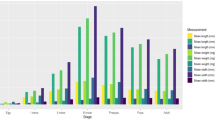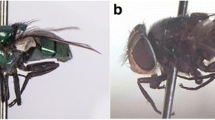Abstract
Purpose
The blowfly Sarconesia chlorogaster (Diptera: Calliphoridae) is of limited forensic use in South America, due to the poorly known relationship between development time and temperature. The purpose of this study was to determine development time of S. chlorogaster at different constant temperatures, thereby enabling the forensic use of this fly.
Methods
Development time of this species was examined by observing larval development at six temperatures (10, 15, 20, 25, 30, 35 °C). The thermal constant (K), the minimum development threshold (t 0), and development rate were calculated using linear regressions of the development time interval at five temperatures (10–30 °C).
Results
Development interval from egg to adult varied from 14.2 to 95.2 days, depending on temperature. The t0 calculated for total immature development is 6.33 °C and the overall thermal constant is 355.51 degree-days (DD). Temperature affected the viability of pupae, at 35 °C 100 % mortality was observed.
Conclusion
Understanding development rate across these temperatures now makes development of S. chlorogaster a forensically useful tool for estimating postmortem interval.


Similar content being viewed by others
Change history
13 November 2020
A Correction to this paper has been published: https://doi.org/10.1007/s12024-020-00331-3
References
Amendt J, Campobasso CP, Gaudry E, Reiter C, LeBlanc HN, Hall MJR. Best practice in forensic entomology—standards and guidelines. Int J Legal Med. 2007;121:90–104.
Amendt J, Richards CS, Campobasso CP, Zehner R, Hall MJR. Forensic entomology: applications and limitations. Forensic Sci Med Pathol. 2011;7:379–92.
Gunn A. Essential forensic biology. Chichester: Wiley; 2006.
Moura MO, de Carvalho CJB, Monteiro-Filho ELA. A Preliminary analysis of insects of medical-legal importance in Curitiba, State of Paraná. Mem Inst Oswaldo Cruz. 1997;92:269–74.
Centeno N, Maldonado M, Oliva A. Seasonal patterns of arthropods occurring on sheltered and unsheltered pig carcasses in Buenos Aires Province (Argentina). Forensic Sci Int. 2002;126:63–70.
Horenstein MB, Arnaldos MI, Rosso B, García MD. Estudio preliminar de la comunidad sarcosaprófaga em Córdoba (Argentina): aplicación a la entomología forense. An Biol. 2005;27:191–201.
Souza ASB, Kirst FD, Krüger RF. Insects of forensic importance from Rio Grande do Sul state in southern Brazil. Rev Bras Entomol. 2008;52:641–6.
Horenstein MB, Linhares AX, Ferradas BR, García D. Decomposition and dipteran succession in pig carrion in central Argentina: ecological aspects an their importance in forensic science. Med Vet Entomol. 2010;24:16–25.
Vairo KP, Corrêa RC, Lecheta MC, Caneparo MF, Mise KM, Preti D, et al. Forensic use of a subtropical blowfly: the first case indicating minimum post-mortem interval (mPMI) in Southern Brazil and first record of Sarconesia chlorogaster from a human corpse. J Forensic Sci. 2015;60:S257–60.
de Carvalho CJB, Ribeiro PB. Chave de identificação das espécies de Calliphoridae (Diptera) do sul do Brasil. Rev Bras Parasitol Vet. 2000;9:169–73.
James MT. Family calliphoridae. In: Papavero N, editor. A catalogue of the Diptera of the Americas South of the United States. São Paulo: Museu de Zoologia da Universidade de São Paulo; 1970. P. 102.1–28.
Dear JP. A revision of the Toxotarsinae (Diptera, Calliphoridae). Pap Avulsos Zool. 1979;32:145–82.
Ikemoto T, Takai K. A new linearized formula for the law of total effective temperature and the evaluation of line-fitting methods with both variables subject to error. Environ Entomol. 2000;29:671–82.
Bonatto SR. Ciclo de vida de Sarconesia chlorogaster (Wiedemann) (Diptera, Calliphoridae, Toxotarsinae), criada sob condições de laboratório em dieta artificial. Rev Bras Zool. 1996;13:685–706.
Wells JD, Lecheta MC, Moura MO, LaMotte LR. An evaluation of sampling methods used to produce insect growth models for postmortem interval estimation. Int J Legal Med. 2015;129:405–10.
Greenberg B, Szyska ML. Immature stages and biology of fifteen species of Peruvian Calliphoridae (Diptera). Ann Entomol Soc Am. 1984;77:488–517.
Queiroz SMP, de Almeida JR, de Carvalho CJB, Dudas L. Bionomia de Sarconesia chlorogaster (Wiedemann, 1830) (Diptera, Calliphoridae) em Curitiba, Paraná, Brasil. An Soc Entomol Bras. 1985;14:105–10.
Krüger RF, Kirst FD, Souza ASB. Rate of development of forensically-important Diptera in southern Brazil. Rev Bras Entomol. 2010;54:624–9.
Estrada DA, Grella MD, Thyssen PJ, Linhares AX. Taxa de desenvolvimento de Chrysomya abiceps (Wiedemann) (Diptera: Calliphoridae) em dieta artificial acrescida de tecido animal para uso forense. Neotrop Entomol. 2009;38:203–7.
Rabêlo KCN, Thyssen PJ, Salgado RL, Araújo MSC, Vasconcelos SD. Bionomics of two forensically important blowfly species Chrysomya megacephala and Chrysomya putoria (Diptera: Calliphoridae) reared on four types of diet. Forensic Sci Int. 2011;210:257–62.
Kipyatkov VE, Lopatina EB. Intraspecific variation of thermal reaction norms for development in insects: new approaches and prospects. Entomol Rev. 2010;90:163–84.
Higley LG, Haskell NH. Insect development and forensic entomology. In: Byrd JH, Castner JL, editors. Forensic entomology: the utility of arthropods in legal investigations. 2nd ed. Boca Raton: CRC Press; 2010. p. 389–406.
Hurlbert SH. Pseudoreplication and the design of ecological field experiments. Ecol Monogr. 1984;54:187–211.
Tryon WW. Evaluating statistical difference, equivalence, and indeterminacy using inferential confidence intervals: an integrated alternative method of conducting null hypothesis statistical tests. Psychol Methods. 2001;6:371–86.
Steidl RJ, Thomas L. Power analysis and experimental design. In: Scheiner SM, Gurevitch J, editors. Design and analysis of ecological experiments. 2nd ed. New York: Oxford University Press; 2001. p. 14–36.
R Development Core Team. R: A language and environment for statistical computing. R Foundation for Statistical Computing, Vienna, Austria. 2011. ISBN 3-900051-07-0. http://www.R-project.org.
Grassberger M, Reiter C. Effect of temperature on Lucilia sericata (Diptera: Calliphoridae) development with special reference to the isomegalen- and isomorphen-diagram. Forensic Sci Int. 2001;120:32–6.
Grassberger M, Reiter C. Effect of temperature on development of the forensically important holarctic blow fly Protophormia terraenovae (Robineau-Desvoidy) (Diptera: Calliphoridae). Forensic Sci Int. 2002;128:177–82.
Donovan SE, Hall MJR, Turner BD, Moncrieff CB. Larval growth rates of the blowfly, Calliphora vicina, over a range of temperatures. Med Vet Entomol. 2006;20:106–14.
Richards CS, Villet MH. Factors affecting accuracy and precision of thermal summation models of insect development used to estimate post-mortem intervals. Int J Legal Med. 2008;122:401–8.
Richards CS, Villet MH. Data quality in thermal summation development models for forensically important blowflies. Med Vet Entomol. 2009;23:269–76.
Boatright SA, Tomberlin JK. Effects of temperature and tissue type on the development of Cochliomyia macellaria (Diptera: Calliphoridae). J Med Entomol. 2010;47:917–23.
Gosselin M, Charabidze D, Frippiat C, Bourel B, Gosset D, Rasmont P. Development time variability: adaptation of Régnière’s method to the intrinsic variability of Belgian Lucilia sericata (Diptera, Calliphoridae) population. J Forensic Res. 2010;1:109.
Tarone AM, Picard CJ, Spiegelman C, Foran DR. Population and temperature effects on Lucilia sericata (Diptera: Calliphoridae) body size and minimum development time. J Med Entomol. 2011;48:1062–8.
Wilson LT, Barnett WW. Degreedays: an aid in crop and pest management. Calif Agric. 1983;37:4–7.
Gennard DE. Forensic entomology: an introduction. Chichester: Wiley; 2007.
Campobasso C, Introna F. Reply: commentary on letter to the editor from Jeffrey Wells. J Med Entomol. 2014;51:492–4.
Acknowledgments
We thank Claudio J. Von Zuben, Marcio R. Pie, Rodrigo F. Krüger, David R. Luz, and Kevin A. Williams who provided helpful comments on a previous version of the paper. This research was partially supported by grants from the Conselho Nacional de Desenvolvimento Científico e Tecnológico (CNPq) (process 312357/2006 and process 307947/2009-2) to M.O.M and Coordenação de Aperfeiçoamento de Pessoal de Nível Superior (CAPES) to M.C.L. James J. Roper provided a careful review of the English language.
Author information
Authors and Affiliations
Corresponding author
Rights and permissions
About this article
Cite this article
Lecheta, M.C., Thyssen, P.J. & Moura, M.O. The effect of temperature on development of Sarconesia chlorogaster, a blowfly of forensic importance. Forensic Sci Med Pathol 11, 538–543 (2015). https://doi.org/10.1007/s12024-015-9727-z
Accepted:
Published:
Issue Date:
DOI: https://doi.org/10.1007/s12024-015-9727-z




